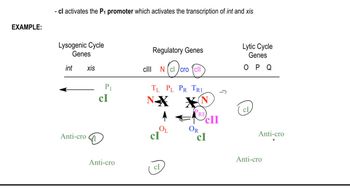Table of contents
- 1. Introduction to Genetics51m
- 2. Mendel's Laws of Inheritance3h 37m
- 3. Extensions to Mendelian Inheritance2h 41m
- 4. Genetic Mapping and Linkage2h 28m
- 5. Genetics of Bacteria and Viruses1h 21m
- 6. Chromosomal Variation1h 48m
- 7. DNA and Chromosome Structure56m
- 8. DNA Replication1h 10m
- 9. Mitosis and Meiosis1h 34m
- 10. Transcription1h 0m
- 11. Translation58m
- 12. Gene Regulation in Prokaryotes1h 19m
- 13. Gene Regulation in Eukaryotes44m
- 14. Genetic Control of Development44m
- 15. Genomes and Genomics1h 50m
- 16. Transposable Elements47m
- 17. Mutation, Repair, and Recombination1h 6m
- 18. Molecular Genetic Tools19m
- 19. Cancer Genetics29m
- 20. Quantitative Genetics1h 26m
- 21. Population Genetics50m
- 22. Evolutionary Genetics29m
7. DNA and Chromosome Structure
Eukaryotic Chromosome Structure
Problem 26b
Textbook Question
DNase I cuts DNA that is not protected by bound proteins but is unable to cut DNA that is complexed with proteins. Human DNA is isolated, stripped of its nonhistone proteins, and mixed with DNase I. Samples are removed after 30 minutes, 1 hour, and 4 hours and run separately in gel electrophoresis. The resulting gel is stained to make all DNA fragments in it visible, and the results are shown in the figure. DNA fragment sizes in base pairs (bp) are estimated by the scale to the left of the gel. Draw a conclusion about the organization of chromatin in the human genome from this gel.
 Verified step by step guidance
Verified step by step guidance1
Step 1: Understand the role of DNase I in the experiment. DNase I is an enzyme that cuts DNA at regions that are not protected by proteins, such as histones. This means that regions of DNA tightly bound to histones or other proteins will remain intact, while unprotected regions will be fragmented.
Step 2: Analyze the experimental setup. Human DNA is stripped of nonhistone proteins, leaving primarily histones bound to the DNA. The DNA is then treated with DNase I at different time intervals (30 minutes, 1 hour, and 4 hours). The resulting DNA fragments are separated by gel electrophoresis, which sorts fragments by size, and the gel is stained to visualize the fragments.
Step 3: Interpret the gel electrophoresis results. Larger DNA fragments indicate regions of DNA that are protected by histones and not cut by DNase I, while smaller fragments represent regions of DNA that were accessible to DNase I and were cut. Over time, the presence of smaller fragments suggests that DNase I progressively cuts accessible regions of DNA.
Step 4: Relate the results to chromatin organization. The presence of both large and small DNA fragments suggests that human chromatin is organized into regions of tightly bound DNA (protected by histones) and regions of more accessible DNA. This supports the idea that chromatin is structured into nucleosomes, where DNA is wrapped around histones, interspersed with linker DNA that is more accessible.
Step 5: Draw a conclusion. The gel results demonstrate that human chromatin is not uniformly protected by histones. Instead, it is organized into a dynamic structure with regions of tightly bound DNA (nucleosomes) and regions of accessible DNA (linker DNA), which reflects the functional organization of the genome for processes like transcription and replication.
 Verified video answer for a similar problem:
Verified video answer for a similar problem:This video solution was recommended by our tutors as helpful for the problem above
Video duration:
1mPlay a video:
Was this helpful?
Key Concepts
Here are the essential concepts you must grasp in order to answer the question correctly.
Chromatin Structure
Chromatin is a complex of DNA and proteins found in the nucleus of eukaryotic cells. It exists in two forms: euchromatin, which is loosely packed and accessible for transcription, and heterochromatin, which is tightly packed and generally inactive. The organization of chromatin influences gene expression and DNA accessibility, making it crucial for understanding how DNase I interacts with DNA.
Recommended video:
Guided course

Chromatin
DNase I Activity
DNase I is an enzyme that cleaves DNA, specifically targeting regions that are not protected by proteins. Its activity is indicative of the accessibility of DNA within chromatin. When DNA is complexed with proteins, such as histones, DNase I cannot cut it, which helps researchers infer the structural organization of chromatin based on the presence or absence of DNA fragments in gel electrophoresis.
Recommended video:
Guided course

Decision Between Lytic and Lysogenic Cycles
Gel Electrophoresis
Gel electrophoresis is a laboratory technique used to separate DNA fragments based on their size. When an electric current is applied, smaller fragments move faster through the gel matrix than larger ones. By analyzing the pattern of DNA bands after staining, researchers can determine the sizes of the fragments and draw conclusions about the chromatin structure and the extent of DNase I digestion over time.
Recommended video:
Guided course

Proteomics
Related Videos
Related Practice
Textbook Question
In a study of Drosophila, two normally active genes, w⁺ (wild-type allele of the white-eye gene) and hsp26 (a heat-shock gene), were introduced (using a plasmid vector) into euchromatic and heterochromatic chromosomal regions, and the relative activity of each gene was assessed [Sun et al. (2002)]. An approximation of the resulting data is shown in the following table. Which characteristic or characteristics of heterochromatin are supported by the experimental data?Gene Activity (relative percentage) _Euchromatin Heterochromatinhsp26 100% 31%w⁺ 100% 8%
397
views


